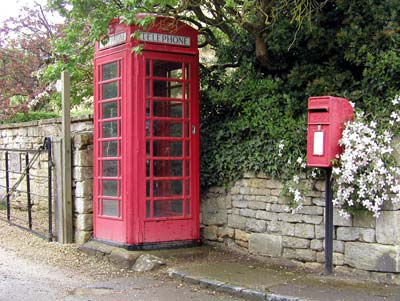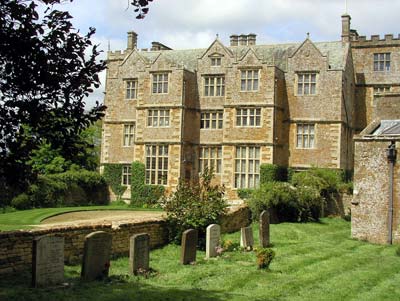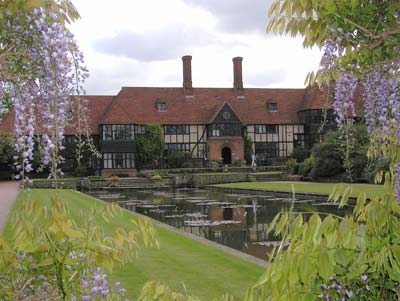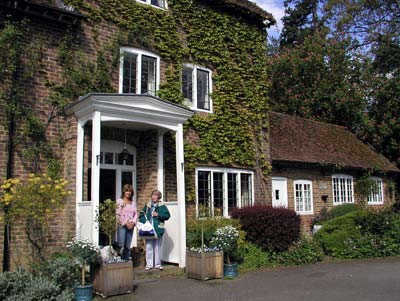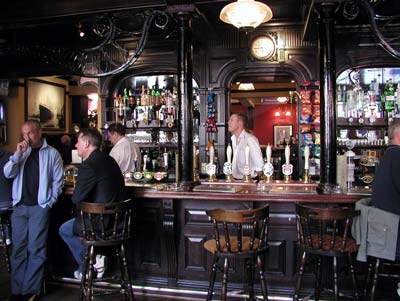Lessons Learned in England
by Harlan Hague, Stockton, CA | Harlan Hague shares more lessons learned when he and his wife, Carol, traveled from France to England in spring 2005 (continued from last month's article).
Our arrival in Dover led to a lesson that, happily, I had learned years ago.
Lesson 6: Beware of locals who tell you “It’s walking distance.”
Hoverspeed ferries arrive at Western Docks in Dover. We were to pick up our rental car at Eastern Docks. In several Internet news groups, locals had said that if you had wheeled luggage you could walk from Western Docks to Eastern Docks. However, I consulted maps of Dover and doubted that that would be wise. We took a taxi and were very glad we did.
We picked up our Avis rental car and were off for East Anglia, which brought us immediately to the next lesson.
Lesson 7: When arriving in Britain on a bank holiday, if you don’t have reservations you had better enjoy sleeping in your car or on the green.
I had learned this lesson the previous year when investigating a trip to England.
On this trip, we indeed arrived on a bank holiday weekend. I had made reservations eight months in advance and even then found two of my three first choices fully booked. But I was fortunate; the one that I booked was a gem and surely would have been my first choice had I seen all three in advance.
We spent the first two nights of our holiday in England at a 17th-century country B&B near Toppesfield. The charming landlady welcomed us with tea in the gazebo.
From there we toured East Anglia, with visits to Lavenham, Finchingfield and other picturesque villages.
We know England, so I had made no other hotel reservations prior to our trip except for booking a room for the last night of our holiday, near Gatwick. This provided flexibility and allowed us to change our itinerary at will, suggesting the next lesson.
Lesson 8: When traveling in an area that you know well, and when you wish to remain flexible, bring a list of possible accommodations and their descriptions, including contact information and directions. Call ahead if you wish to book a particular place or drive by to look at it first. Also, bring along a list of places that you might wish to visit and things that you might wish to do.
Before leaving Toppesfield, I pulled out my list of potential accommodations, called a B&B at Debden, near Duxford, and booked a couple of nights.
Early on we had pondered spending some time in the countryside west of Cambridge, but with the plan to return to Duxford a week later than originally scheduled — so that we could time our visit to its Imperial War Museum to correspond with an air show to commemorate VE Day — we drove directly to the north Cotswolds, where we had lived years ago and to which we return as often as possible.
The drive was pleasant though not without miscues and misdirections. Though we generally know England well, no one but locals can know the small lanes and keep up with the new road building and changes in road numbers. I had put off buying new maps and suffered by the neglect.
When I saw the first road sign for a Cotswold town that I recognized, I breathed easier and knew that I was home. I had not made reservations for the Cotswolds, assuming that I would find something suitable utilizing the following lesson, which I had learned years ago.
Lesson 9: Consult local tourist information offices for attractions and accommodation.
There was a time when I would drive around looking for a B&B in a setting that I liked, taking a look inside before booking, but I learned that this was too time-consuming and that the local tourist information office not only had local listings but could help make a suitable choice after I had explained what I wanted.
Now I routinely book at the tourist information office if I have not made advance reservations.
In Stow-on-the-Wold, we booked a B&B just off the square for the minimum two nights. We liked it so much that we extended our stay.
We visited old haunts, stopping in at the Moreton-in-Marsh Tuesday market and the pottery in Evenlode for another cup. We drove through some lovely villages on a rainy afternoon and had gingerbread and tea at the Women’s Institute in Moreton, where ghosts of old friends, now gone, saddened us. The W.I. serves tea in its meeting hall every Tuesday market day. The hall is located on a side street just steps from the market.
On another day we visited the grave of a dear friend in the Chastleton church cemetery and walked the delightfully restored grounds of the majestic Chastleton House.
Back road directory
One of our greatest pleasures, one which began during the time we lived in the North Cotswolds, is discovering new lanes and villages. We never fail to find one or two on every trip. On this trip we discovered Sezincote, only 2½ miles from Moreton.
I had seen the small road sign for Sezincote scores of times and simply thought it a strange name for an old village. None of our English friends who had taken us or directed us to many local places of historic and scenic interest had ever mentioned it.
What we discovered was not a village but an interesting oddity for the Cotswolds: a beautiful house and garden influenced by two brothers’ fascination for things Indian. Both had served in India in the late 18th century.
Displaying both Hindu and Muslim detail, the house makes for a rewarding visit. It is reported that the Prince Regent was so impressed with Sezincote during his visit in 1812 that he was inspired to complete his plan for an Indian facade to his Marine Pavilion in Brighton.
The house is open May-September on Thursday and Friday afternoons (2:30-5:30). Admission costs £6 ($12) and includes the house and gardens. (Children are allowed with special permission only.) The garden is open January-November, Thursdays, Fridays and bank-holiday Mondays, 2-6 p.m. (£4 adult, £1.50 child).
From the Cotswolds, we returned to Duxton for the air show and museums. It was a cold, windy day with occasional showers, but it was thoroughly enjoyable. The air show was fun and a fine tribute to the airmen of Britain and the United States who had fought side by side, some departing from this airfield.
The American museum contained a wonderful collection of vintage and recent American aircraft. Other museums showed British aircraft and restoration displays.
Chasing an obsession
Leaving Duxton, we drove to Southampton, taking the motorway all the way. While not on every visitor’s itinerary, it was a high point of our trip (well, my wife’s, at least).
To put it mildly, Carol is a Titanic zealot. She collects Titanic books, pamphlets, articles, music and paraphernalia of all sorts. Since Southampton was the departure port and remains associated with the story of the ship, we had to go to Southampton.
We arrived in mid-afternoon and drove to Mayflower Park in the dock area, where a VE Day celebration was in full swing. We were just in time to see the last few passes of the flyover and listen to the band playing songs from the 1940s. Some hardy souls danced, no doubt to the same songs they had danced to in the war years. It was in some ways more moving than the Duxford event.
Afterward we drove back to the tourist information office for a B&B booking and maps, then we set out on the self-guided Titanic walking tour. We saw the impressive Titanic Memorial and monuments to the Titanic crew, engineers, musicians and ship’s post office workers.
We also saw the former South Western Hotel, now luxury apartments, where the first-class passengers spent the night before boarding, and walked down the road to the Canute Chambers, where the White Star Line posted news of the disaster and families gathered for any word about survivors.
We had wine at The Grapes, the pub frequented by the Titanic crew (and the film’s camera crew; they shot the scene here in which Jack won the berth on the Titanic).
We tried to walk to Dock 4, from which the Titanic departed, but it is a busy dock area and we could go only as far as the memorial plaque. Carol was disappointed. I think she was hoping to see the boarding and departure.
The next morning we visited the Maritime Museum, on the corner of Bugle Street and Town Quay Road, which featured displays of Southampton’s association with the sea. The Titanic section upstairs includes a large model and photographs. We made a pilgrimage to the nearby Mayflower Monument, erected in memory of those who departed from there for New England. We finished on the waterfront in Mayflower Park, Carol looking for some mystical evidence of the Titanic’s passage. She didn’t want to leave.
The best for last
From Southampton we drove eastward, stopping briefly at Chichester for lunch and a walk, then continued northward to the Weald and Downland Open Air Museum near Midhurst. The museum features a collection of historic buildings brought there for preservation from all over the south of England. It is a “must see” for anyone interested in England’s cultural and architectural history.
The next day we drove to Wisley, the Royal Horticultural Society’s premier garden, in Surrey. Somehow we had never visited before, and it turned out to be the high point of the trip, for me.
I was fearful that it would be as unrewarding as other gardens in England had been thus far, as spring had come late that year, but I was not disappointed. Wisley is simply magnificent.
We spent almost the entire day there and got only a glimpse of the 200 acres. To really enjoy Wisley, plan to see as much as you can, but leave time for sitting down and contemplating a particularly inviting vista.
We were there in early May, but I would wager that it is as pretty in summer and early fall. For lunch there is a nice cafeteria-style restaurant, but go a bit early; it gets quite crowded.
Wisley is open year-round, except Christmas Day. Admission is £7.50 ($15) for adults.
Our final B&B was located on the outskirts of Charlwood village, a few miles west of Gatwick. We have stayed in accommodations near Gatwick that ranged from mediocre to barely acceptable. I’ll not have to search again. Wayside Manor Farm henceforth will be our stopping place when flying out of Gatwick.
The nearby Fox Revived pub has a nonsmoking conservatory dining area with a view of the garden that is delightful. It is the only pub I have seen whose bar is lined with full bookshelves.
Finally, I’ll add one more lesson.
Lesson 10: Think twice about planning a trip to Western Europe in spring. The weather can be magnificent, but it can also be awful. Consider a trip in early autumn, when the weather is generally more settled. Early summer is a good second choice.
England accommodations
• Toppesfield (near Halstead) — Ollivers Farm (phone 01787 237642, www.essex-bed-breakfast.co.uk/index.htm) was one of my favorite B&Bs out of decades of traveling in Britain. And it is in an excellent location for touring East Anglia. Rates start at £27.50 ($55) per person, double, including a full English breakfast.
• Debden (near Saffron Walden) — Redbrick House (phone 01799 540221, www.s-h-systems.co.uk/hotels/redbrickhou.html), located in a small village convenient to Duxford and Cambridge, was a pleasant accommodation. A double room costs £25 ($49) per person, including a full English breakfast.
• Stow-on-the-Wold — Number 9 (phone 01451 870333, www.number-nine.info) is a testimony to the wisdom of consulting local tourist information offices, as we found our Stow B&B at the local office. It’s a gem, with down-home, friendly owners. Rooms range from £60 to £70 ($118-$138) per night, including breakfast.
• Southampton — Fenland Guest House (phone +44 [0]2380 220360, www.fenlandguesthouse.co.uk) was comfortable and conveniently located near the town center. Rates range from £28 to £55 ($55-$108) per room, including breakfast. We also stayed a night at Four Seasons Guest House (74 Howard Rd.), a basic, bathroom-down-the-hall B&B guest house. Carol loved it. Room rates start at £22 ($43).
• Charlwood (near Gatwick) — I feel like the guy who is about to reveal the location of his secret favorite fishing hole, but here it is. Wayside Manor Farm (phone +44 [0]1293 862692, www.wayside-manor.com), at the edge of the village, is among my favorite English B&Bs. All rooms are doubles with facilities en suite (£70, or $138, per night including breakfast).


